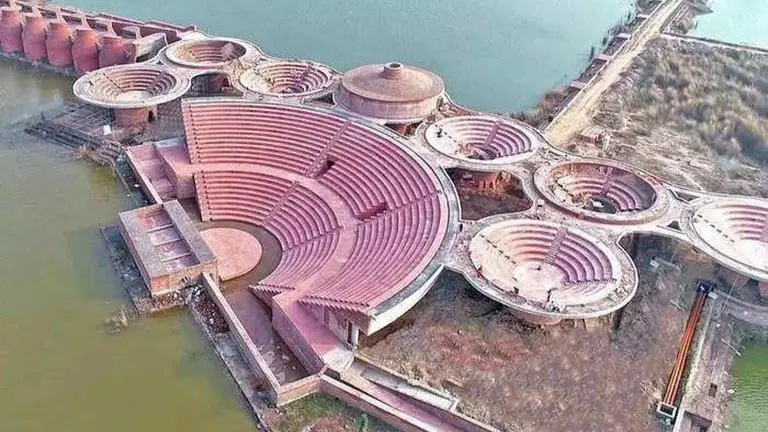Updated 15 February 2022 at 20:17 IST
A thousand years after it was destroyed, Nalanda University to reclaim past glory
Nalanda University's campus with state-of-the-art infrastructure, recreated in the same layout as it was in past, is ready to be inaugurated by PM Modi soon.
- World News
- 4 min read

Once revered as the world's largest education hub, the Nalanda University, demolished by the Islamic invaders in the late 12th century, is on its way to reclaiming lost glory. Functioning as a leading educational institute in the pre-Islamic period, Nalanda University finds mention in Persian, Chinese, Buddhist and Jain and texts from across the world.
Before its recognition as a center for knowledge, Nalanda has been described in Jain and Buddhist texts as a 'sacred space'. It was a place where Mahavira had met Gosala, where infamous disciple of Buddha-- Sariputta was born, and where Buddhist scholar Dinnaga (480 CE-540 CE) defeated the Brahmin Sudurjaya.
Records of Buddhist monk Hiuen Tsang, who travelled from China to India during the reign of King Harsha Vardha show that its transformation as an educational hub began when it started receiving land endowments, gifted to it in honour of Buddha after Emporer Ashoka established a vihara (monastery) in Nalanda. Patronage of various kings over time added to its grandeur with the university being adorned with beautiful sculptures. Here is the history of the institution, its downfall, and its ultimate rise in 21st century India.
Rise as an educational hub
The Nalanda University has been documented as an open school of discussions, where scholars would hold regular arguments and study both Buddhist and Hindu scripture studies including Vedas, Yogasastras, and Panini’s grammatical works. A center for higher studies, it attracted foreign scholars and experts from China, Korea, Tibet, and Tokhara who would collaborate and debate under one roof. In fact, Chinese traveller I-tsing describes Nalanda as a 'democratically governed body'.
Advertisement
The Fellowship of the university was regarded as the highest academic degree of those times. Entrance examinations into Nalanda were very hard to pass, and Hiuen Tsang documents only 20% could secure admissions. Around 100 lectures were arranged daily and about 1,500 teachers were in charge of the estimated 8,500 students enrolled there. Once enrolled, students were given free lodging, food, clothing, and education.
After braving through a series of invasions, its glory was ultimately brought to a halt after a series of plundering raids by Turk invader Muhammad bin Bakhtiyar Khalji in the late 12th century CE. Persian historian, Minhaj-i-Siraj has vividly described the violent loot and massacre describing the mass burning of Nalanda's library and records and the murder of its monks.
Advertisement
Reclaiming lost glory
Taking the first step towards reinventing the old Nalanda, former President of India, Dr. A.P.J. Abdul Kalam spoke about reviving the ancient university while addressing the Bihar State Legislative Assembly in March 2006. Simultaneously, the Singapore government presented the “Nalanda Proposal” to the Government of India suggesting the re-establishment of Nalanda as the focal point of Asia. The same was reiterated at the fourth EA Summit held in October 2009, where more member states affirmed their support to the University, thereby getting the process rolling.
A stretch of 450 acres of land at the base of the Rajgir Hills was identified and acquired to house its campus. The Nalanda University Act 2010 was passed in both the Houses of the Indian Parliament and a high degree of cooperation between the Bihar Government and the Centre thus, marked the establishment of Nalanda University in its new avatar.
The academic session of NU started on September 1, 2014, with then-External Affairs Minister Sushma Swaraj reiterated the Centre’s full ownership of NU. From 2014 to 2020, Nalanda University enrolled 710 regular students, though major infrastructure work on the Nalanda University only started in 2017 and took shape in the last 4 years.
Its new campus with state-of-the-art infrastructure, reportedly recreated in the same layout as it was in past (1193 AD), is ready to be inaugurated by PM Narendra Modi very soon. NU has now also launched a global master’s programme in Hindu Studies (Sanātana) and has begun witnessing admissions from students from the US, Vietnam, Sri Lanka, Bangladesh etc on its way to restoring the glory of the past.
Restoring our glorious past. Thank you, PM @narendramodi ji. #NalandaUniversity pic.twitter.com/2HVEbIDeNt
— Pralhad Joshi (@JoshiPralhad) February 14, 2022
Published By : Ananya Varma
Published On: 15 February 2022 at 20:17 IST
